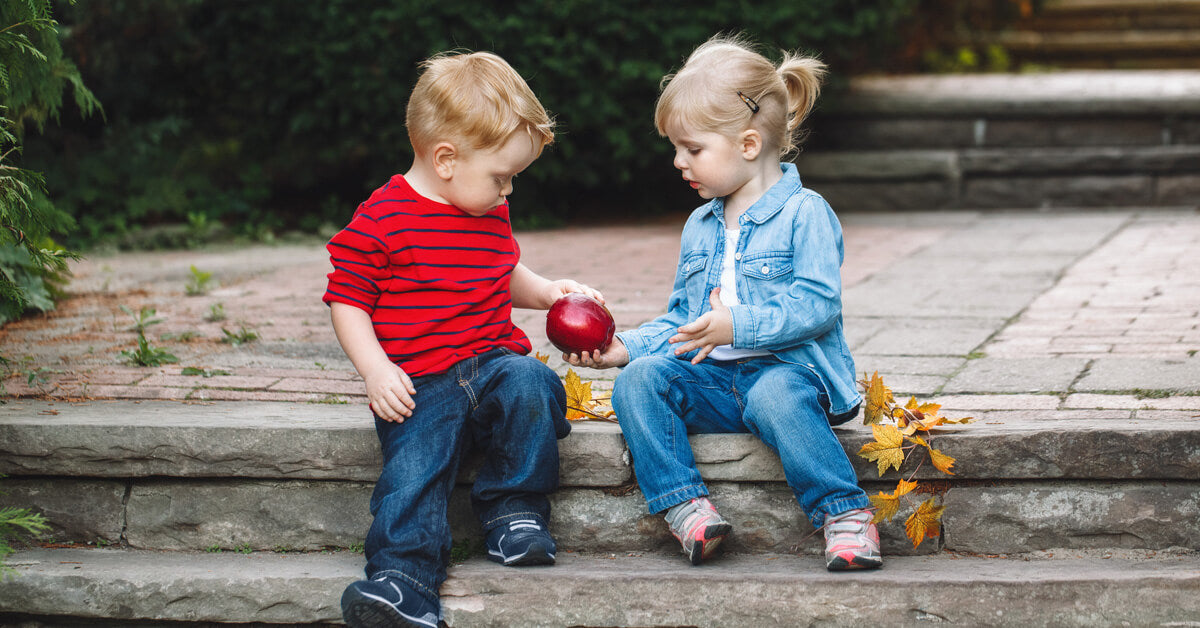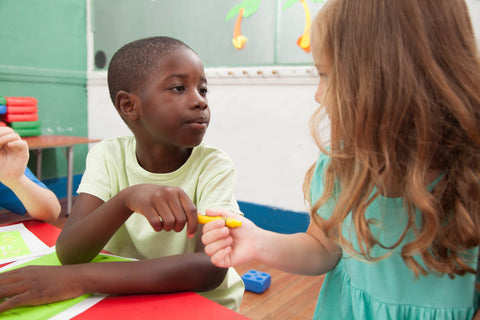
Teaching Children About Sharing
From exchanging toys to taking turns on the playground, sharing is an important skill to master in early childhood. Read on for tips on how to encourage your children to share.
"Sharing is caring" is a refrain often heard during childhood. But how does one go about teaching a child to share? Children are naturally curious and protective about power and control, and being forced to share can throw a wrench into those desires.
Even though it may be difficult for a young toddler to grasp the concept of sharing, parents and caregivers can encourage children to share with one another from a young age. From exchanging toys to taking turns on the playground, sharing is an important skill to master in early childhood.
Sharing is difficult, especially for young children.
Kids are naturally possessive creatures. Once your little one is old enough to explore the world around her, she will likely begin declaring what objects and activities belong to her. From a young child's point of view, they don't have ownership of very many things in this world, so it is natural for them to not want to share the few things that do belong to them.
Part of the human experience is learning empathy and compassion for others. Children are naturally self-oriented, so understanding another child's point of view is a learned skill. Children learn by example, so being vocal about your own sharing with others can be a helpful part of the process.
Parents can teach kids to share, even at a young age. Encourage sharing from the start, and your little one will be set up to become a well-adjusted, compassionate, understanding friend and peer.
Parents can teach young children to share by utilizing these two strategies.
1. Don't jump in and fix every conflict.
Jumping in and fixing the problem doesn't help your children learn to share. As much as you can, try to remain on the sidelines when you see a conflict arise. If your child refuses to share a toy with another child, don't run in and grab the toy and give it to the other child. If your child doesn't want to let another child play with them or engage in an activity with them, don't step in and force your child to include everyone. If your little one yanks a toy out of someone else's hands, don't rush over and give your child a lecture on how to take turns. Give the child a chance to try to figure out conflict resolution before you intervene.
A parent might say something like, "Wow, both of you really want to play with that special dinosaur toy. I see that it's making you angry that your friend won't share the toy with you yet. I see that your friend is upset that you are trying to take the toy out of his hands before it is your turn. Maybe we should try setting a timer so we know how long each friend has with the dinosaur. That way, we can practice turn taking." Parents, educators, and family members can act more like narrators than referees. Simply narrating the situation and identifying feelings can be a great way for toddlers and preschoolers to learn about emotions and empathy.
Words matter, so be aware of how you choose to talk about a conflict scenario. Make sure that each child feels heard and cared for, and the kids are more likely to be kind and generous with their friends. Whenever you see children sharing, encourage them and give lots of positive feedback. Children naturally search for approval from adults and caregivers, so be sure to notice when positive behaviors and conflict resolution is occurring.
Give your child space to practice coming up with a solution himself. You might just be surprised what your kids are capable of!
2. Address the "big picture" issues first.
There is no one-size-fits-all method when it comes to parenting and teaching kids to share, but big picture issues should always be addressed first. Although it can be helpful for parents to give children a chance to resolve conflict on their own, they need to step in immediately at the first signs of aggression.
If a child pushes over a baby to get to a toy, a preschooler hits another child when he won't share his activity, or other aggressive behaviors such as biting or pulling occur, parents should step in and take over before the children start fighting or getting injured. Don't wait until a child is hurt before you intervene in the conflict if it involves acts of aggression.
If conflict about sharing involves aggression, parents can:
-
Narrate the scenario. For example, a parent might say something like, "I saw you knock your friend over when you were running to use the bike. Look how your friend is sad and hurt his knee on the sidewalk. Maybe it is too soon for you to be playing outside. Let's take a break and make sure your friend is okay before we try to practice turn taking on the bikes."
-
Model empathy and calming techniques. Kids look up to parents as a natural part of development, so be sure to model compassion and respect for others in a way that young children can pick up on. Encourage behavior like using kind words, identifying feelings, taking turns, sharing toys at school, and including others in activities and games. If a child is feeling upset, model calming techniques such as deep breathing, taking a break, or squeezing your hands. These are skills that will set children up for success both at home and at school.
-
Expect that aggression is a normal part of development. Kids crave power and control, and aggression is often a way for a young child to achieve that. Behaviors such as hitting, pushing, grabbing, and pinching are all related to a child's growing sense of autonomy and control. Children search out ways to assert their power, so be sure to respect a child's boundaries and developmental abilities in an age-appropriate manner (for example, a baby will not hit out of spite, but a preschooler might). It is never okay to hurt another person, but kids lack the coping skills to navigate conflict without using physical aggression. Parents and caregivers can be great resources and role models for young children to learn from in life.
At what age should you teach young children how to share with one another?
Possessiveness is common and expected for toddlers and preschoolers. Parents should not assume a two year old is capable of understanding the importance of sharing a toy or engaging in fair play with other kids. Sharing is a learning experience, and there will be times that children need an adult's help navigating certain situations.
Sharing is about both having compassion and giving up control.
Even adults have a hard time letting go of possessions depending on their mood. Adults can feel a sense of loss and nervousness around sharing things, so why should we expect our kids to be any different?
In order to understand why a child might have difficulty sharing toys or other things, adults must see the situation from the child's viewpoint. Make sure that your child feels cared for, heard, and supported when you approach the concept of sharing.
Children are inexperienced when it comes to social rules. Parents should set realistic expectations when it comes to their child's ability to feel empathy for their friends and peers. Don't get bogged down by parental expectations and adult perspectives. Sharing is a learning experience for young kids.
An older sibling might not share with a younger sibling as a way of asserting control. There has been a big change in the family dynamic, and holding onto "stuff" is a common impulsive behavior for kids going through a big transition. Possessiveness can be a way to combat negative feelings around change and instability.
Parents can help their kids develop the practice of sharing by following these tips:
-
Acknowledge your child's feelings of frustration and encourage expression of negative emotions
-
If your child acts out (in a nonviolent manner), let it go
-
Do not make your response ro misbehavior too urgent
-
Narrate the situation without judgment
-
Let your child be seen and heard
-
Let your child know you are interested in what is going on
-
After the first misbehavior, you can try intervening
-
Empathize with the child's struggle
-
Let the meltdowns happen because that is how a child releases their feelings
-
Encourage the child to choose special toys to put out during play dates
-
Don't be too bound by "house rules" and social norms
-
Set behavior limits when your child is clearly stuck
Sharing can be a learning experience for kids. As they learn to play with one another, sharing is an important part of their social development. Sharing with friends is a social skill that enhances connection and bonding.
Taking toys away from one child and giving them to another child, or forcing a child to wait and take turns, can actually be forms of division and not connection. Parents can set their children up for a successful social experience by teaching them how to share with one another.
Teaching children to share is a way for parents to help their kids become kind, generous, compassionate friends who are able to engage in positive social behaviors. By encouraging sharing behavior at a young age, caregivers can promote children's social and emotional development.
|
|
Meet Our KeaMommy Contributor: Kaitlyn Torrez I’m Kaitlyn Torrez, from the San Francisco Bay Area. I live with my husband and two children, Roman and Logan. I’m a former preschool teacher, currently enjoying being a stay at home mom. I love all things writing, coffee, and chocolate. In my free time, I enjoy reading, blogging, and working out. |































































